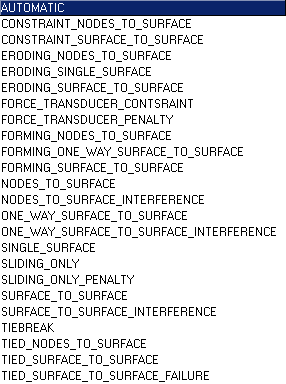
- Contact Proximity Factor
defines the distance used to evaluate which mesh is within contact with mesh in other parts. For each of the selected parts, mesh between the parts will be evaluated a contact region between the parts will be created.
Note: A mesh file must be loaded for this feature.
- Parts
specifies the parts for which contact will be defined. By limiting the number of parts and modifying the contact proximity factor, you can control the contact regions.
Note: Often it is easiest to select all parts.
- Create one contact group for all parts
if enabled, one contact group will be created for all the selected parts.
- Static Coefficient of Friction
The static coefficient of friction (µ) between two surfaces is defined as the ratio of the tangential force (F) required to produce sliding divided by the normal force between the surfaces (N):
µ = F /N
The static coefficient of friction is used in the contact definition to define the resistance of the two parts under contact.
- LS-DYNA Contact Options
The contact cards that are supported are listed in the figure below. For further details, refer to the LS-DYNA manual.
- Automatic Contact Option
For further details, refer to the LS-DYNA manual.
- Dynamic Coefficient of Friction
The dynamic coefficient of friction or kinetic friction is used to define the friction under contact when the two parts are in motion relative to each other (in contrast to the static coefficient of friction).



